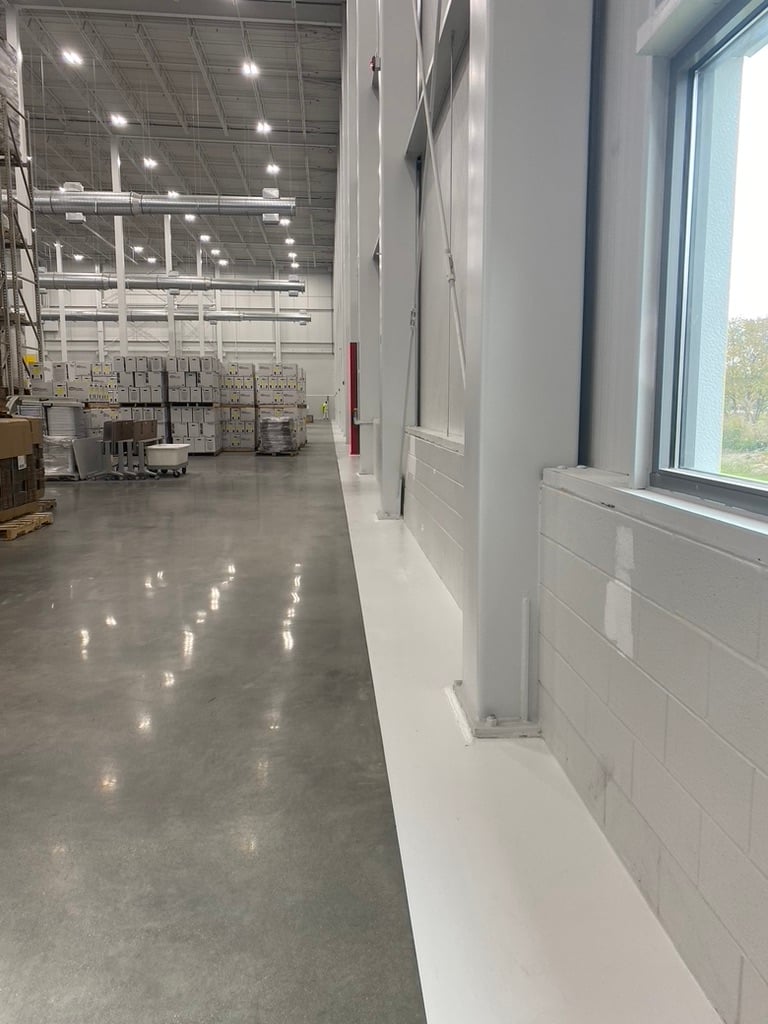

July 23rd, 2025
3 min read
By Tom Dassie

In a warehouse, the floor has to do more than just sit beneath your feet—it supports constant movement, heavy machinery, and nonstop workflow. Whether you're managing thousands of pounds of inventory or running forklifts around the clock, the right flooring makes a direct impact on safety, productivity, and long-term operational costs.
At CustomCrete, we've worked with countless warehouse and distribution centers to deliver high-performance concrete flooring solutions that meet the demands of heavy use. With decades of experience installing epoxy, urethane cement, and polished concrete in industrial environments, we understand what it takes to create floors that stand up to daily abuse while remaining safe and easy to maintain.
In this blog, we’ll break down what flooring features matter most for forklift traffic and inventory movement—and which options best support warehouse efficiency and durability.
Forklifts don’t just move boxes—they add significant weight and force to a floor, especially when turning, stopping, or transporting stacked loads. Meanwhile, inventory movement involves rolling carts, hand trucks, conveyor systems, and storage racks. These all contribute to wear and tear.
A floor that can’t keep up becomes a liability. Damaged or uneven flooring can:
To avoid these issues, the flooring must offer both durability and a smooth, even surface.
When evaluating flooring systems for heavy use, these are the primary features to look for:

Let’s look at which flooring systems meet the needs of busy warehouse environments.
Polished concrete offers a clean, professional finish and is suitable for warehouses that want low-maintenance floors without coatings. There’s no coating to peel or reapply, the reflective surface can improve lighting, and it is dust-proofed and stain-resistant when densified and sealed.
However, it can become slick if not properly textured, is not suitable for areas with chemical spills or temperature extremes, and cracks and joints are still present and may require maintenance.
Epoxy is one of the most common choices for warehouses. It forms a tough, seamless surface that can be customized in thickness, texture, and color. Epoxy offers excellent durability and chemical resistance, and it’s easy to clean and maintain. It can also include non-slip textures and line striping, and bonds well to concrete with proper prep.
However, installation can take multiple days and must be done correctly to avoid peeling or bubbles. It’s also not ideal for environments with wide temperature swings unless modified.
Urethane cement is a step up in durability. It’s ideal for facilities that require extreme thermal shock resistance, chemical protection, or high compressive strength. It offers superior resistance to abrasion, heat, moisture, and chemicals, with an extremely long lifespan under heavy traffic and low maintenance needs. The tradeoff is a higher upfront cost than epoxy and a more complex installation process.
For facilities using forklifts, properly filling control joints is a critical part of the flooring system. This prevents wheel damage and reduces jarring impacts. It allows for smooth transitions for forklifts and carts, protects slab edges, and reduces maintenance over time.
Line striping can be used to mark forklift lanes, inventory zones, caution areas, or pedestrian paths—improving both safety and workflow.
In addition to function, some warehouses need visual organization. Epoxy coatings can incorporate color zones for forklift routes, pedestrian lanes, or inventory staging areas. Urethane and epoxy systems also support decorative flakes or textures if branding or aesthetics are a concern.
No matter the look, durability should never be sacrificed. A floor should match the environment’s needs, not just the desired appearance.
Choosing the best flooring for forklift traffic and inventory movement isn’t just about materials—it’s about how those materials work in your space. Think about what your team, equipment, and operations demand from the floor beneath them.
Whether you're building new or resurfacing an old slab, the right flooring system can prevent downtime, reduce long-term maintenance costs, and improve safety and efficiency.
If you're not sure which solution fits your facility, start with an assessment of your traffic patterns, load weights, chemical exposures, and cleaning needs. Or read this next article, “What Industrial Concrete Flooring Solution is Best for Forklifts?”.